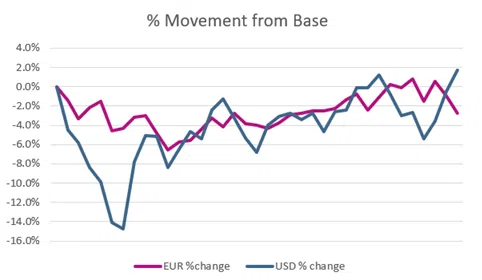Global businesses are already feeling the pressure of volatile exchange rates, especially with current economic trends heavily influenced by movements in the US economy. But there’s an often-overlooked aspect causing hidden cost increases: customs duty costs.
Even businesses that carefully hedge their currency exposure are not immune. That’s because the exchange rate used for customs declarations is set externally, in the UK, for example, HMRC publishes monthly customs rates, which don’t necessarily align with real-time market rates.
How Customs Exchange Rates Work
When goods are imported, the customs value (which determines how much duty and VAT is payable) must be calculated using the origin currency converted to sterling using the official customs exchange rate, not the rate the business might have achieved in its commercial hedging.
- Set Monthly: HMRC (and similar authorities globally) publish monthly rates based on average exchange rates from a prior period.
- Out of Sync with Market Rates: These can differ significantly from spot rates or forward contract rates and considerably from hedged rates.
- Binding for Declarations: Importers must use the customs rate, even if it means declaring a higher value (and paying more duty and VAT) than they actually paid.
Why This Matters Now
- Higher Costs Without Warning: With the dollar and other major currencies moving sharply, the customs rates may reflect past periods of strength, even if current market rates have changed.
- Hedging Doesn’t Help: Companies that hedge their purchases based on commercial exposure still have to apply the customs rates, creating a gap between financial planning and customs cost reality.
- Cash Flow and Pricing Pressures: Increased duty and VAT liabilities can affect cash flow and profitability, especially where recovery is delayed or where goods are re-exported and the VAT must be reclaimed later.
The Customs Rate Effect
This chart uses HMRC’s official rates to show the percentage movement from the base exchange rate for the USD and EUR customs exchange rates between May 2022 and May 2025.
While both currencies fluctuate, the USD shows significantly greater swings, particularly in late 2022, when it was over 14% stronger than its starting point, before gradually recovering. The euro, meanwhile, has remained more stable, though consistently trading below the base rate for most of the period.
The key implication for importers is that these customs rate movements directly affect the customs value of goods declared in the UK, regardless of the commercial or hedged rates a business achieves. When customs rates strengthen, companies are forced to declare a higher customs value, triggering higher duty and VAT costs even if they paid less in their transaction currency.

Finance teams may see these costs rising without an obvious operational explanation, leading to variances in landed costs, cash flow pressures from higher import VAT, and margin erosion that standard FX hedging strategies won’t mitigate.
This highlights the need for finance leaders to monitor customs exchange rates alongside market rates actively, and to factor customs-driven FX variance into cost forecasting, budgeting, and risk management.
A Practical Example
Imagine a business imported $1 million worth of goods in April. Their hedge locked in a rate of 1.25 USD/GBP — great! But HMRC’s customs rate for April was based on a much weaker pound at 1.20 USD/GBP.
- Commercial Invoice Value: $1m @ 1.25 = £800k.
- Customs Value: $1m @ 1.20 = £833k.
They pay duty and VAT on £33k more than expected — a cost not visible in their original budget or hedge.
What Businesses Can Do
- Monitor HMRC Customs Rates: Keep an eye on monthly customs exchange rate publications.
- Invoice in a less volatile currency, or Sterling if a UK importer.
- Adjust Budgeting Models: Build potential customs rate variances into landed cost calculations.
- Consider Advance Planning: For major shipments, knowing upcoming customs rates can help you time your imports better.
- Reclaim Where Possible: Use customs regimes like Inward Processing or returned goods relief to minimise exposure where applicable.

While market hedging strategies are essential, they won’t protect businesses from customs valuation surprises. Now more than ever, companies need to recognise that customs exchange rates operate on their own system — and unseen increases in customs costs could be quietly eroding margins.
Source for rates: HMRC currency exchange monthly rates – GOV.UK
Understanding the disconnect between commercial exchange rates and official customs rates is not optional, it’s essential. These quiet shifts in customs valuation can have a material impact on profit margins, pricing decisions, and cash flow. For finance, procurement, and compliance teams, integrating customs rate awareness into cost planning isn’t just a technical fix, it’s a commercial safeguard.
If your business is seeing unexplained variances in landed costs or margins, it may be time to take a closer look at how customs exchange rates are playing a role.
Talk To An Expert
Need help with customs compliance or looking to save on costs?
Share your contact details, and one of our experts will be in touch to assist!
Related Posts
29 July 2025
Fear, Avoidance, and Customs Compliance: What CFO’s Should Know
Many CFOs quietly acknowledge that…
15 July 2025
Customs Unsung Heroes: Why Finance Teams Should Stop Overlooking Their Customs Function
In many businesses, the customs team…
30 June 2025
Is Your Customs Function Truly Under Control? A Quiet Risk Finance Leaders Can’t Ignore
In most businesses, customs compliance…


